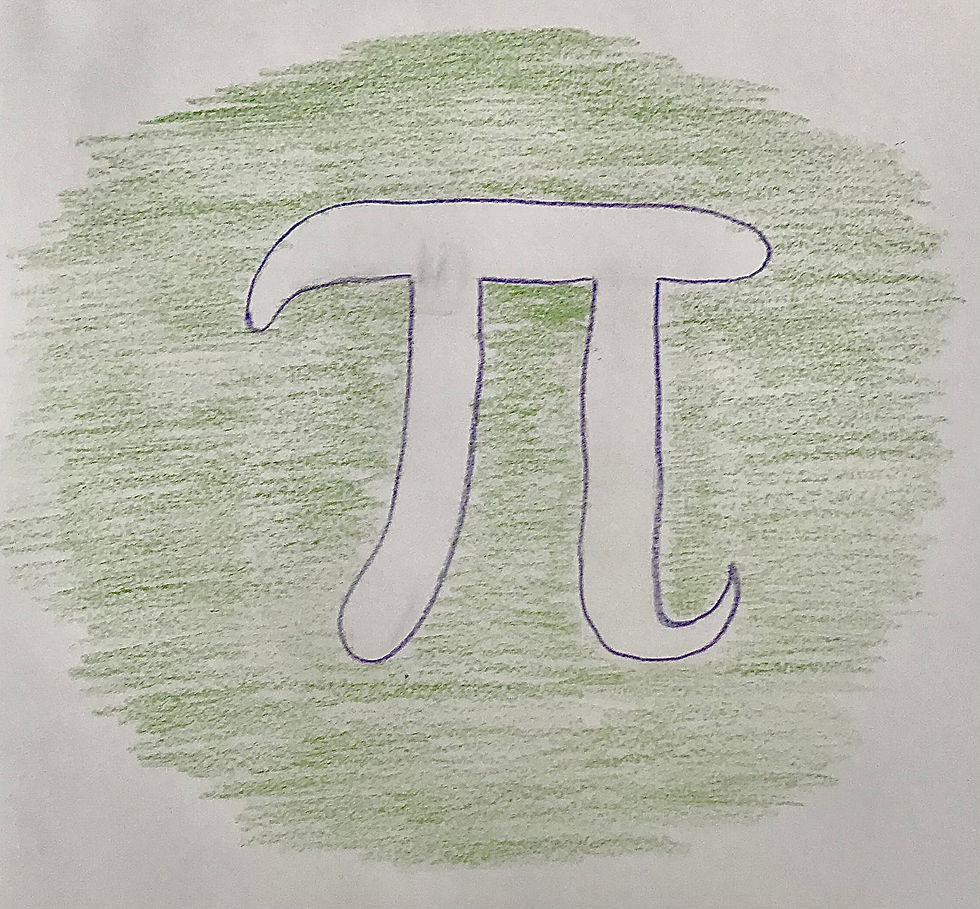It's All Greek!
- Natalie Lee

- Jan 9, 2021
- 5 min read
Pi. The number with an infinite amount of digits. Of course, its value is approximately 3.14, but what fascinates many people is that the digits go on and on:
3.1415926535897932384626433832795028841…
Pronounced as “pie” and represented by the greek letter π, it is one of the many Greek letters that appear in mathematics. Where did the Greek alphabet come from and why are its letters so abundant in math and science?

Fun Fact: The Greek alphabet is the ancestor to all modern European alphabets, whether directly or indirectly.

The birth of the Greek alphabet can be traced back to around 1000 BCE. This writing system was derived from the North Semitic alphabet, which was used by the Phoenicians, a group of ancient people who resided in what is now the eastern Mediterranean area. The Greeks took the 22-consonant alphabet and evolved it into a 24-letter alphabet with seven vowels (five of the original consonants were converted into vowels). Vowels are important because they can help capture more complex sounds in speech and put them into writing. Any letters they added were placed at the end of the alphabet, keeping all the letters in a specific order so that it would be easy to remember. There are two versions of the Greek alphabet used today: Classical and Modern. The Modern version is what Grecians use today. The Classical version is the one found in math and science.
Fun Fact: The word alphabet comes from the first two letters of the Greek alphabet: alpha and beta.
So why are Greek letters used in mathematics? The answer is quite simple. Besides the fact that the Greek language is one of the oldest European languages, spoken and written, many mathematicians were from Greece, including Aristotle, Archimedes, Euclid, and Pythagoras. Pythagoras may sound familiar if you’ve ever taken a geometry class—from his famous Pythagorean theorem:
a^2 + b^2 = c^2

This formula is used to determine a side of a right triangle, provided you know the other two sides. Although this particular equation doesn’t use any Greek letters, some other equations do. Those Greek letters represent specific values or variables throughout math and science. Some letters might even have different meanings depending on the context. It’s important to remember that each letter has an uppercase and lowercase version, and each version may represent something different.
In the next section, we have a list of all the Greek letters I have encountered in math and science and how I remember using them. Of course, there are other Greek letters in math and science, but I thought it would be fun to add a slight personal twist to it! Keep in mind that in the parentheses, the uppercase Greek letter is displayed first and is followed by the lowercase Greek letter. Some letters look the same as a letter in the Latin alphabet, which is the alphabet I am using to write this article.
Fun Fact: In a constellation, Greek letters are used to order the stars by size. Alpha would be the largest star, beta would be the second-largest star, and so on.
Alpha (Α, α)
You may have heard of the term alpha being used to describe the leader of a wolf pack or some other animal group—that’s because alpha is the first letter in the Greek alphabet and is often used to denote something that comes first. I’m most familiar with using lowercase alpha in physics to represent angular acceleration, which is the acceleration of a rotating object. I’ve also seen it used to denote certain angles, usually the “first” angle of a triangle. In biology, proteins have different levels of structures, and the α-helix is part of the secondary structure.
Beta (Β, β)
Similar to alpha, as the second letter of the Greek alphabet, beta often describes a sub-leader who acts right under the alpha. Lowercase beta has been used to symbolize the “second” angle of a triangle. In biology, the second part of a protein’s secondary structure is the β-pleated sheet.
Delta (Δ, δ)
Unlike many of the letters on this list, I have encountered the uppercase delta more than I have encountered the lowercase delta. The uppercase delta represents any difference or change, from the slope of a line (Δy/Δx) in algebra to derivatives (Δx = dx) in calculus. In physics, ΔV (V representing voltage) means the change in the voltage (something I learned about in my current physics class!). On the other hand, I have used the lowercase delta in chemistry to denote partial charges within a molecule.
Epsilon (Ε, ε)
I have used a version of the lowercase epsilon called epsilon naught as an electric constant: ε_0 ≈ 8.854 x 10^-12 F/m (which is Farads per meter). I used it specifically for Gauss’s law in physics.
Theta (Θ, θ)
Lowercase theta is commonly used to represent any arbitrary angle.
Kappa (Κ, κ)
I have seen lowercase kappa denote the curvature of a function. It can also represent the dielectric constant when calculating the capacitance of a parallel-plate capacitor. A dielectric is a material you can put between the two plates to raise the capacitance of a parallel-plate capacitor (which means that in this case, κ > 1).
Lambda (Λ, λ)
The lowercase of this Greek letter can signify the linear density of an object in physics, whether it’s the mass density or charge density. It has also shown up as wavelength in physics and the Lagrange multiplier in calculus.
Mu (Μ, μ)
The most common use for lowercase mu is to represent a measurement in “micro” terms, which is 10^-6. Otherwise, I have seen it used as the population mean in statistics.
Pi (Π, π)
The most famous Greek letter and the first one you learned about is probably pi (in its lowercase form). As mentioned in the introduction, pi has an infinite amount of digits, making it a special number. This value is the ratio between the circumference and the diameter of a circle. It is used to calculate many values involving curved shapes and objects such as the area of a circle and the volume of a cone.
Rho (Ρ, ρ)
I have used lowercase rho to denote the density, particularly volume density, of an object in physics, whether it’s the mass density or charge density.
Sigma (Σ, σ)
Sigma is another Greek letter on this list where I have used both uppercase and lowercase forms. Uppercase sigma symbolizes the sum of a set of values in math. Lowercase sigma represents the standard deviation of a population measure in statistics.
Tau (Τ,τ)
Although it’s hard to see here, lowercase tau has a little curve at the bottom that sweeps to the right. I have used lowercase tau to denote torque, which is the rotational force (as opposed to the linear force).
Phi (Φ, φ)
I believe I used uppercase phi to represent an arbitrary angle, usually if there was already an angle named with lowercase theta.
Chi (Χ, χ)
I have used lowercase chi for the chi-squared test in biology and will most likely encounter it in statistics. This test is used to determine if a null hypothesis is true.
Psi (Ψ, ψ)
I’m not sure if I used the lowercase or the uppercase version of psi, but I have used one of them to denote water potential in biology.
Omega (Ω, ω)
As the last letter in the Greek alphabet, you may have heard omega refer to the lowest ranking wolf in the pack. I have encountered both uppercase and lowercase omega before. Uppercase omega represents a unit of measurement: ohms. The unit ohms (Ω) is the measure of electric resistance. I have also used lowercase omega to represent angular velocity, which is the velocity of a rotating object. It is important to remember that velocity is just speed with a direction.
If you want to explore more uses for Greek letters in science and math, the internet is a great resource. For instance, you can take a look at this website: The Most Common Uses of All the Greek Letters in Science, Maths and Engineering. I think that Greek letters are one of the examples of how there are many ancient methods, theories, and more that remain an integral part of our lives today. Writing this article brought back some memories! I hope you learned something new today! Keep a lookout for the next post!

Comments